One of the most popular and productive styles of fishing along the NSW coastline is rockhopping.
For many years I’ve enjoyed catching all sorts of fish off the rocks and have seen many others hook into plenty. However, our coastal headlands and rock platforms aren’t easy places for the beginner to start, so here I’ve put together a number of tips which should result in a few tasty fish on the dinner table.
The very first thing anyone who fishes the rocks should be aware of is safety – more people die fishing off the rocks than during any other sport or pastime in Australia.
Staying safe on the rocks comes from a combination of understanding weather forecasts, being able to make judgments when looking at the sea, wearing appropriate clothing and simply using a bit of commonsense.
Never even consider fishing the rocks if the seas are big or predicted to increase in size.
That means taking notice of the weather forecast on the evening news and perhaps consulting a few different websites.
In basic terms, if the seas or swell are predicted to be over 2m then it could mean that rock fishing will be too dangerous for the inexperienced.
If the seas reach 3m then rock fishing is out altogether, regardless of how much experience you have.
If the seas are only 1m today but predicted to rise to 2m or 3m by tomorrow, that also means that rock fishing is out and perhaps the beaches or estuary are better options.
What generally causes the swell to increase is either a southerly change moving up the coast or a large low-pressure system out in the Tasman Sea or off the southern Queensland coast.
So when watching weather forecasts, always take note of these weather systems and their position on the map.
So if sea or weather conditions allow, the next step is to study the spot you intend to fish for at least five minutes before venturing down to start fishing.
Most often there will be a lull for a few minutes and then a few larger waves will roll in. Surfers call these the sets.
The larger waves are what you have to look out for and if they are washing all over the rocks, there’s no point even thinking about having a go there.
If all is fine, though, it’s time to head on down and get ready for a fish.
It’s important to have footwear that will keep you upright.
Basically, there are two types of rock.
Slippery, smooth or weedy rocks mean that metal cleats bolted to your sandals or shoes will give you a better grip.
On the other hand, grippy rubber soles are better on most high and dry rocks. Thongs are not an option and hard soled shoes aren’t much better.
The sea conditions can also effect the way you need to fish or the species that you’re hoping to catch.
Generally speaking, really calm, flat seas may seem appealing but they’re not what the fish like. Good conditions for most species are a slight 1m swell that creates some whitewash close in around the rocks.
Really clear, calm water that we often encounter during late Winter or Spring is the hardest to extract fish out of, but there are things you can do like using lighter line, smaller hooks and some berley to encourage fish to take a bait.
Flat, clear seas are generally a symptom of westerly winds.
The angler’s friendly winds are a light southerly, south-easterly or a light north-easterly.
A light south-westerly may not be too bad, but the worst wind direction when trying to catch fish off the rocks is a north-westerly.
When picking a spot to fish, look for prominent features like points, gutters that cut back into the rocks, sections of broken reef or rock and deep ledges that drop straight down at your feet.
Difficult places to fish are those gently sloping ledges that mean there is a lot of rock in front of you. If possible, try to avoid those spots or you’ll end up getting snagged more often than you would like.
All types of rod-and-reel combinations can be used off the rocks and some will suit certain species or situations while others won’t.
One of the mistakes I often see people making is to use rods that are too short. Yes, there are times when a short rod will work wonders and I often use gear that is more suited to catching bream or flathead in the lakes or rivers.
However, if you’re new to the game a longer rod will mean fewer snags, more fish and easier fishing. A longer rod will keep line further away from rocks close in and enable you to cast lightly weighted baits or lures further, if need be.
Alvey sidecast reels are great for rock fishing because they are simple and robust, but a decent threadline reel will be easier to use for most people.
If using just one outfit for rock fishing, a lightweight 3.6m with a medium-sized 4000 to 6000 size threadline reel will be ideal.
Spooled up with 6 to 8 kilo mono or braid, you’ll be able to tangle with a range of species with this sort of gear.
Braid can be used for rock fishing but I advise sticking with good old nylon mono for most of your basic rock fishing applications, it will just make things a lot easier. After a while you may like to try braids for some styles of rock fishing.
A simple backpack or carry bag with a small tackle box, knife, pliers, a fish scaler and keeper net complete the kit, although a bucket will also come in handy.
A hat and polarised sunglasses will help protect you from the sun and the glasses will also enable you to see into the water, spotting rocks or reef. And don’t forget sunblock, the burn out there can be bad at times.
A huge variety of species can be caught from the rocks, but the main ones are bream, blackfish, drummer, groper, tailor, salmon, bonito, trevally, kingfish, frigate mackerel and leatherjackets.
With a more specialised approach other fish like larger tuna, jewfish, snapper or cobia are a good chance in some places.
Through the cooler months we have the ‘bread ’n’ butter’ species like bream, drummer, blackfish and tailor making up the bulk of the rockhopper’s catch.
From mid-Summer to late Autumn those faster pelagics like bonito, tuna and kingfish are on the cards.
Top baits for the bread ’n’ butter species include pilchards, strips of mullet or tailor, peeled prawns, cunjevoi, crabs, green sea cabbage and plain white bread.
Of these, I’ve found pilchards, prawns and white bread to be very reliable and the green cabbage is always good for drummer and blackfish.
Whole pilchards on ganged hooks are very effective on tailor and salmon, but will also interest kingfish, bonito, tuna, snapper and bigger bream.
Fresh squid is another top bait which is particularly appealing to kingfish, jewfish and, at times, drummer and groper.
Berley can be a god idea to encourage fish to move in and take baits.
While almost anything can be used for berley, it’s hard to go past a few loaves of bread soaked in a bucket of water and mashed up to a pulp.
You can add extras like tuna oil, prawn shells, green cabbage or Ultrabite just to spice it up a bit.
When using berley off the rocks, it’s a better idea to throw in small amounts regularly, rather than a heap all at once. Another tip is to drop it in close to the rocks you’re fishing from so it’s more likely to bring fish closer to you.
A rising tide is nearly always better than a falling tide when rock fishing.
However, we should also be aware that a rising tide could also mean that waves may start spilling over the rocks towards high tide. So, when possible, try to time your outing so you start fishing just after low tide and then fish for a few hours as the tide rises.
Fish like bream, groper and blackfish can be caught right through the day, but it’s those low-light periods early in the morning or later in the afternoon when fish tend to be more active.
A rising tide early in the morning or of an evening is prime time for most species.
Rock fishing may not be for everyone and, as mentioned earlier, it doesn’t come without certain hazards.
But if you take note of the forecasts, use a bit of commonsense and use suitable tackle and bait at the right times, the rocks can also be very rewarding.
Bream are one of the most commonly encountered fish around the rocks. This one was caught on plain white bread but other good bream baits include peeled prawns, cut pilchards or strips of fresh mullet or tailor.
Drummer are some of the toughest opponents you’ll hook when rock fishing. They tend to favour areas of broken rocks and reef with some whitewater spilling over their heads. Bread, cunjevoi, peeled prawns and green cabbage are all top drummer baits.
A few bream and dart moved in when some bread-based berley mix was hurled into the water. Most fish around our rocks respond well to bread as berley or bait.
Ideal conditions for rock fishing are a small, safe swell, with some whitewater close in around the rocks.
Tailor will take a range of baits and lures, but it’s hard to beat pilchards pinned to a set of ganged hooks fished early in the morning or later in the afternoon.
Light gear and a bread bait presented under a float worked well to take this blackfish.
A strip of fresh mullet or tailor on a size 1/0 hook is perfect when the bream are around.
Bread, mixed with sea water and mashed to a pulp, is a fantastic berley for rock fishing. Bream, blackfish, drummer and trevally really love this stuff.
Often regarded as difficult fish to catch, blackfish can actually be easy targets when using bread baits on small hooks.
Reads: 5668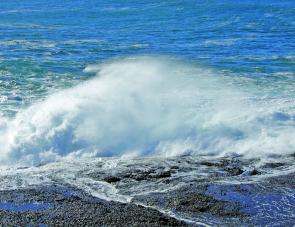
Never go rock fishing when the seas are up. If you turn up and see large waves spilling over the rocks like this, the best bet is to simply turn around and leave rather than risking your life.

-

-
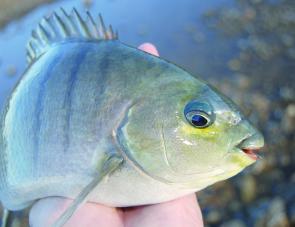
-

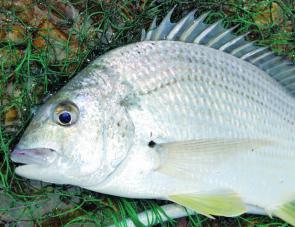
-

- Plenty of blackfish can be caught around our rocks. Although most are caught by experienced anglers drifting cabbage baits under floats, they will also take white bread baits with enthusiasm.

-
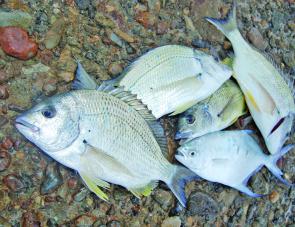
-
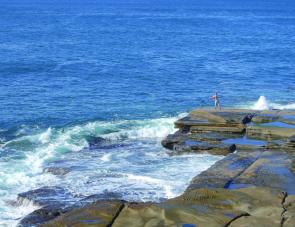
-
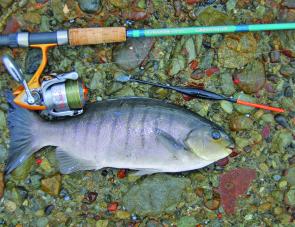
-




